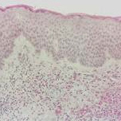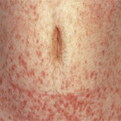Drug-Induced Photosensitivity
General Information
Drug-induced Photosensitivity refers to the development of a cutaneous disease resulting from both a chemical and light effect, exposure to only one component will not cause the disease. Both phototoxic and photoallergic reactions occur in sun-exposed areas of skin (e.g. the face, V of the neck, and dorsa of the hands and forearms). A widespread eruption suggests exposure to a systemic photosensitizer, whereas a localized eruption indicates a reaction to a locally applied topical photosensitizer. Treatments include topical corticosteroids and cool compresses to alleviate the condition, corticosteroids should be reserved for more severe cases. The drug classes that currently are eliciting a high level of adverse photosensitivity are the diuretic, antibacterial and nonsteroidal anti-inflammatory drugs (NSAIDs).
Epidemiology
Uncertain in the US, phototoxic reactions are considerably more common than photoallergic reactions.
Etiology
Prolonged sun exposure while on systemic medications or topically applied compounds
Pathogenesis
Manifested by a delayed erythema and edema, followed by hyperpigmentationand desquamation
Clinical
Often begins as an exaggerated sunburn. Vesicles and bullae may develop. Separation of the distal nail plate from the nail bed may also develop.
Histology
In acute phototoxic reactions, necrotic keratinocytes are observed. If the reaction is severe, the necrosis is panepidermal. In photoallergic reactions, spongiosis with a dermal lymphocytic infiltrate is a prominent feature.
Bibliography
1. “Photosensitivity Reactions” (Online) August 2007. http://www.merck.com/mmhe/sec18/ch214/ch214c.html (visited: March 16, 2008) 2. “Drug-Induced Photosensitivity” (Online). March 2007. http://www.emedicine.com/derm/topic108.htm#section (visited: March 16, 2008)
Download PDF
![]() Drug-Induced Photosensitivity
Drug-Induced Photosensitivity


